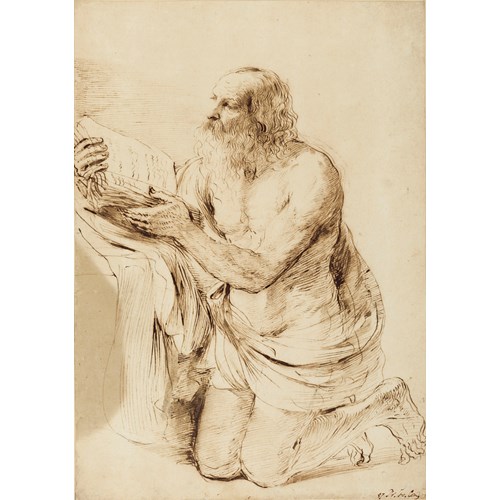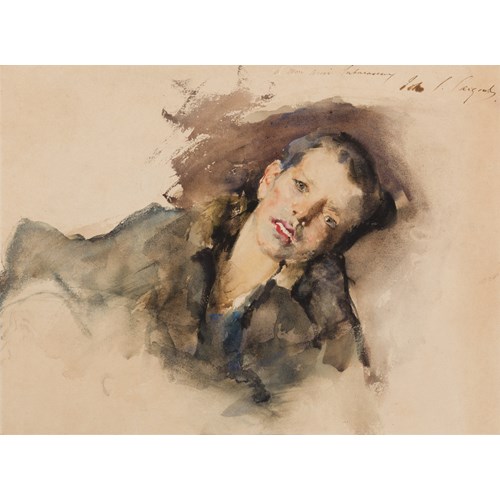Piero Buonacorsi, PERINO DEL VAGA
Caesar on the River Aoös
Period 1400-1600, 16th Century
Origin Italy
Medium Pen and brown ink, Brown wash, Heightened with white, Underdrawing in black chalk
Dimension 13.7 x 15.2 cm (5³/₈ x 6 inches)
A closely related drawing appears on the recto of a double-sided sheet of small compositional sketches and figure studies by Perino del Vaga formerly in the Reynolds, Calando and Lebel collections and today in the collection of Georges Pébereau in Paris. The lower sketch on the recto of the Pébereau sheet is clearly preparatory for the composition of the drawing here under discussion, and the two are very similar in size and scale, with the sketch on the former measuring approximately 136 x 182 mm. The present sheet must have been worked up from the preliminary sketch on the Pébereau drawing, although there may have been other, intervening studies.
While the sketch of Caesar on the River Aoös on the Pébereau drawing shows Perino at his lightest and most fluent, the present sheet is a carefully worked-up modello, with strong and decisive line-work. The differences in the composition of this drawing and that in the Pébereau collection mainly involve the placement of the figures, notably the oarsman and the master of the boat, while the empty stern of the boat in the later drawing serves as a visual platform for the gestures of Caesar’s astonished soldiers. The forms are carefully modelled with white heightening, delicately and precisely applied with the tip of the brush, which serves to emphasize the relief nature of the composition. The overall effect is inspired by Roman sarcophagus reliefs, and it would seem likely that this drawing was intended for a relief-like composition, probably in grisaille.
While the dating of the present sheet is difficult to establish with any precision – not unusual in the work of an artist whose graphic chronology remains notoriously unstable – it would seem to have been made fairly early in Perino’s career. Joannides has suggested that the present sheet was drawn before Perino’s move to Genoa in 1527. The closest analogies in style and technique are with such drawings of the early 1520’s by Perino as the Scene of Pillage in the Devonshire collection at Chatsworth and the Martyrdom of the Ten Thousand in the Albertina, in which the application of heightening in white bodycolour is closely comparable.
This visual sophistication evident in the design of this drawing of Caesar on the River Aoös, and the related sketches of Caesarian narratives on the Pébereau sheet of studies, would suggest that the unknown project for which they were preparatory was the result of a commission from a patron of refined taste and knowledge, perhaps someone at the papal court in Rome. Such a frieze of scenes from the life of Caesar can well be imagined as an apt decorative scheme for the façade or interior of a Roman palace.
Period: 1400-1600, 16th Century
Origin: Italy
Medium: Pen and brown ink, Brown wash, Heightened with white, Underdrawing in black chalk
Signature: Inscribed Cesar Ini…[M]iro il fiume…I aniene(?) in the lower margin and, in a different hand (Lanier?), Polidoro in the lower right margin.
Dimension: 13.7 x 15.2 cm (5³/₈ x 6 inches)
Provenance: Nicholas Lanier, London (Lugt 2886)
Probably John Evelyn, Deptford and London
By descent to J. H. C. Evelyn and Major Peter Evelyn
Their posthumous sale, London, Christie’s, 6 July 1977, part of lot 1 (as Circle of Perino del Vaga)
Private collection, England
Anonymous sale, New York, Christie’s, 28 January 1999
Anonymous sale, London, Phillips, 13 December 2000, lot 121 (as attributed to Pirro Ligorio)
Mia Weiner, New York
Private collection, Madrid.
Literature: Paul Joannides, ‘Some New Drawings by Perino del Vaga’, in Elena Parma, ed., Perino del Vaga: prima, durante, dopo. Atti delle Giornate Internazionali di Studio, Genova 26-27 maggio 2001, Palazzo Doria “del Principe”, Genoa, 2004, pp.18-19, fig.7; Elena Parma, ‘Introduzione’, in Parma, ed., ibid., p.8; Dominique Cordellier, Louis-Antoine Prat and Carel van Tuyll van Serooskerken, ed., Maîtres du dessin européen du XVIe au xxe siècle: La collection Georges Pébereau, exhibition catalogue, Paris, Musée du Louvre, 2009-2010, p.20, fig.1, under no.2 (entry by Dominique Cordellier).
More artworks from the Gallery









